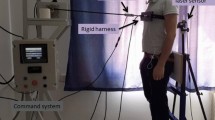Abstract.
Two behavioral goals are achieved simultaneously during forward trunk bending in humans: the bending movement per se and equilibrium maintenance. The objective of the present study was to understand how the two goals are achieved by using a biomechanical model of this task. Since keeping the center of pressure inside the support area is a crucial condition for equilibrium maintenance during the movement, we decided to model an extreme case, called “optimal bending”, in which the movement is performed without any center of pressure displacement at all, as if standing on an extremely narrow support. The “optimal bending” is used as a reference in the analysis of experimental data in a companion paper. The study is based on a three-joint (ankle, knee, and hip) model of the human body and is performed in terms of “eigenmovements”, i.e., the movements along eigenvectors of the motion equation. They are termed “ankle”, “hip”, and “knee” eigenmovements according to the dominant joint that provides the largest contribution to the corresponding eigenmovement. The advantage of the eigenmovement approach is the presentation of the coupled system of dynamic equations in the form of three independent motion equations. Each of these equations is equivalent to the motion equation for an inverted pendulum. Optimal bending is constructed as a superposition of two (hip and ankle) eigenmovements. The hip eigenmovement contributes the most to the movement kinematics, whereas the contributions of both eigenmovements into the movement dynamics are comparable. The ankle eigenmovement moves the center of gravity forward and compensates for the backward center of gravity shift that is provoked by trunk bending as a result of dynamic interactions between body segments. An important characteristic of the optimal bending is the timing of the onset of each eigenmovement: the ankle eigenmovement onset precedes that of the hip eigenmovement. Without an earlier onset of the ankle eigenmovement, forward bending on the extremely narrow support results in falling backward. This modeling approach suggests that during trunk bending, two motion units – the hip and ankle eigenmovements – are responsible for the movement and for equilibrium maintenance, respectively.
Similar content being viewed by others
Author information
Authors and Affiliations
Additional information
Received: 1 July 1999 / Accepted in revised form: 23 October 2000
Rights and permissions
About this article
Cite this article
Alexandrov, A., Frolov, A. & Massion, J. Biomechanical analysis of movement strategies in human forward trunk bending. I. Modeling. Biol Cybern 84, 425–434 (2001). https://doi.org/10.1007/PL00007986
Issue Date:
DOI: https://doi.org/10.1007/PL00007986




